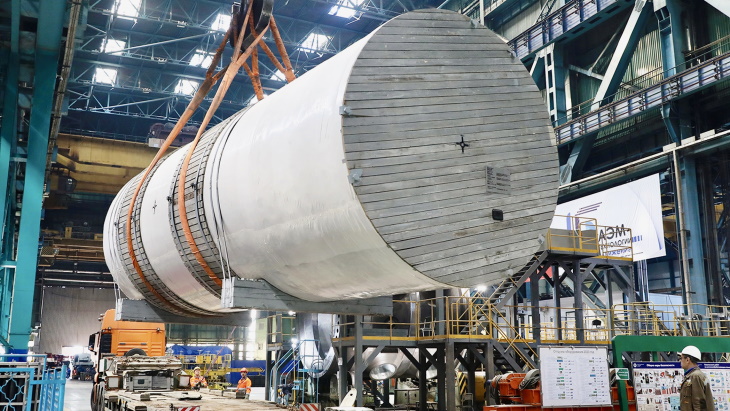The reactor internals - including a 10-metre internal shaft, a baffle and a block of protective pipes - have been delivered to the construction site of the first power unit at Kursk II in western Russia.

The 10-metre internal shaft for Kursk II-1 (Image: Rosatom)
The internals were manufactured by the Volgodonsk branch of JSC AEM-Technologies (part of the machine-building division of Rosatom - Atomenergomash).
All the components will be installed within the unit's reactor vessel, where they will be hermetically sealed with the reactor lid. The in-vessel devices separate the coolant flows in the reactor, fuel assemblies are placed inside them, and channels of the reactor control and protection system pass through them.
"All elements of the internal devices have previously passed a test assembly at the factory with a standard VVER-TOI reactor pressure vessel," noted Andrey Osharin, acting director of the Kursk plant. "A 10-metre internal shaft weighing 73 tonnes, a baffle weighing 38 tonnes and a block of protective pipes weighing 68 tonnes were lowered inside. Next, the nuclear reactor was closed with a standard lid. The total weight of the assembled product was 603 tonnes.
"During the control assembly, all elements completely repeat their design position. This significantly reduces the assembly time and simplifies the installation of the reactor plant directly at the nuclear power plant construction site."
The 340-tonne, 12-metre reactor vessel was installed at Kursk II-1 in June last year.
Kursk II is the first project to use the VVER-TOI design - a Generation III+ power unit - and was developed using technical results from the VVER-1200 project. The design offers improved safety measures, including an increased margin of safety from extreme impacts and ability to withstand earthquakes, and is equipped with modern control systems and diagnostics, Rosatom said.
First concrete for Kursk II unit 1 was poured in April 2018, while that for unit 2 was poured one year later.
Kursk II will replace four RBMK units at the site.
Researched and written by World Nuclear News